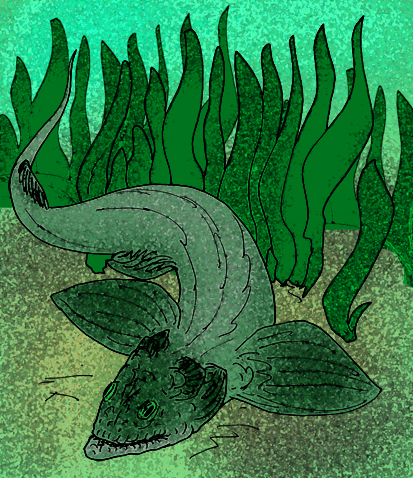- Pseudopetalichthyida
Taxobox
name = Pseudopetalichthyida
status = fossil

image_caption = "Pseudopetalichthys problematicus"
regnum =Animal ia
phylum =Chordata
subphylum =Vertebrata
classis =Placodermi
ordo = Pseudopetalichthyida
familia = Paraplesiobatidae
subdivision_ranks =Species
subdivision =
*"Pseudopetalichthys problematica"†
*"Paraplesiobatis heinrichsi" †
*"Nessariostoma granulosa" †<The Pseudopetalichthyida was a group of extinct, skate-like fishes known only from rare fossils in Lower Devonian strata in
Hunsrück , Germany. Like "Stensioella heintzi ", and theRhenanida , the Pseudopetalichthids had armor made up of a mosaic of tubercles. Like "Stensioella heintzi ", the Pseudopetalichthids' placement withinPlacodermi is suspect. However, due to a gross lack of whole, uncrushed, articulated specimens, there are no other groups that the Pseudopetalichthids could be, for a lack of a better word, pigeonholed into.On the other hand, according to anatomical studies done on the crushed specimens that have been found, those experts who do regard the Pseudopetalichthyida as placoderms consider them to be a group more advanced than the
Ptyctodont s. And as such, pro-placoderm experts consider Pseudopetalichthyida to be the sister group of theArthrodires +Phyllolepida +Antiarchi trichotomy and theAcanthothoraci +Rhenanida dichotomy .The best known, and aptly named species is "
Pseudopetalicthys problematica ". Some experts have suggested that "Paraplesiobatis heinrichsi " is the same species as "P. problematica", but, due to the specimens of the latter species being crushed in a different position than the specimen of the former species, the anatomies of the two forms appear different (Moy-Thomas & Miles). However, this problem will be resolved only with more specimens. The anatomy of the specimens of "Nessariostoma granulosa " are sufficiently different from the other two pseudopetalichthyids to be recognized as a separate species. "N. granulosa" bears a superficial resemblance to "Stensioella heintzi ", and it was this resemblance that originally lead to the pseudopetalichthyids' grouping within Stensioellidae.References
* Long, John A. "The Rise of Fishes: 500 Million Years of Evolution" Baltimore: The Johns Hopkins University Press, 1996. ISBN 0-8018-5438-5
* Moy-Thomas, J. A. & Miles, R. S. "Paleozoic Fishes" (2nd ed)Chapman and Hall, London, 1971.External links
* [http://www.fmnh.helsinki.fi/users/haaramo/Metazoa/Deuterostoma/Chordata/Placodermi/Placodermi.htm Mikko's Phylogeny Archive]
Wikimedia Foundation. 2010.
